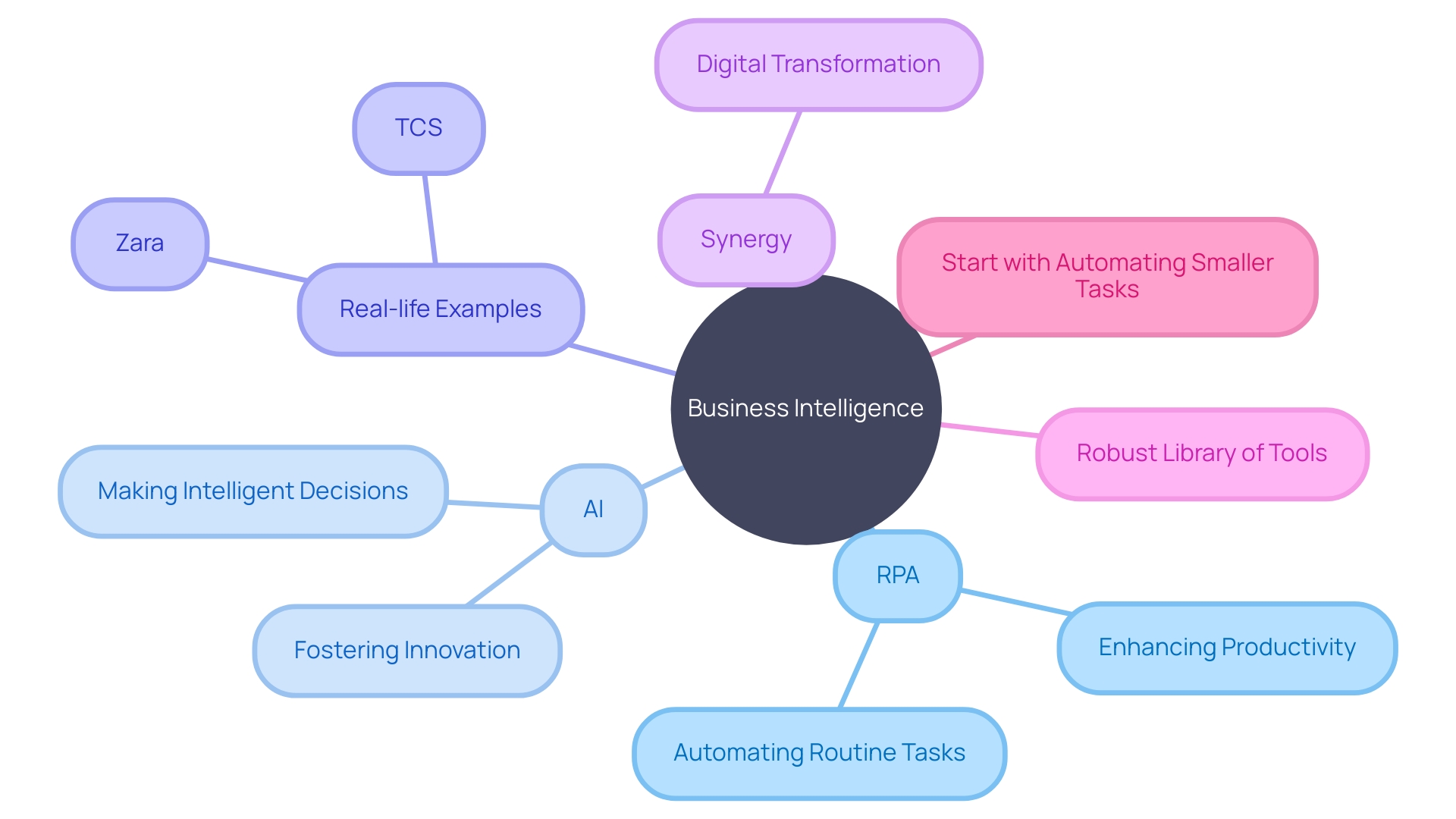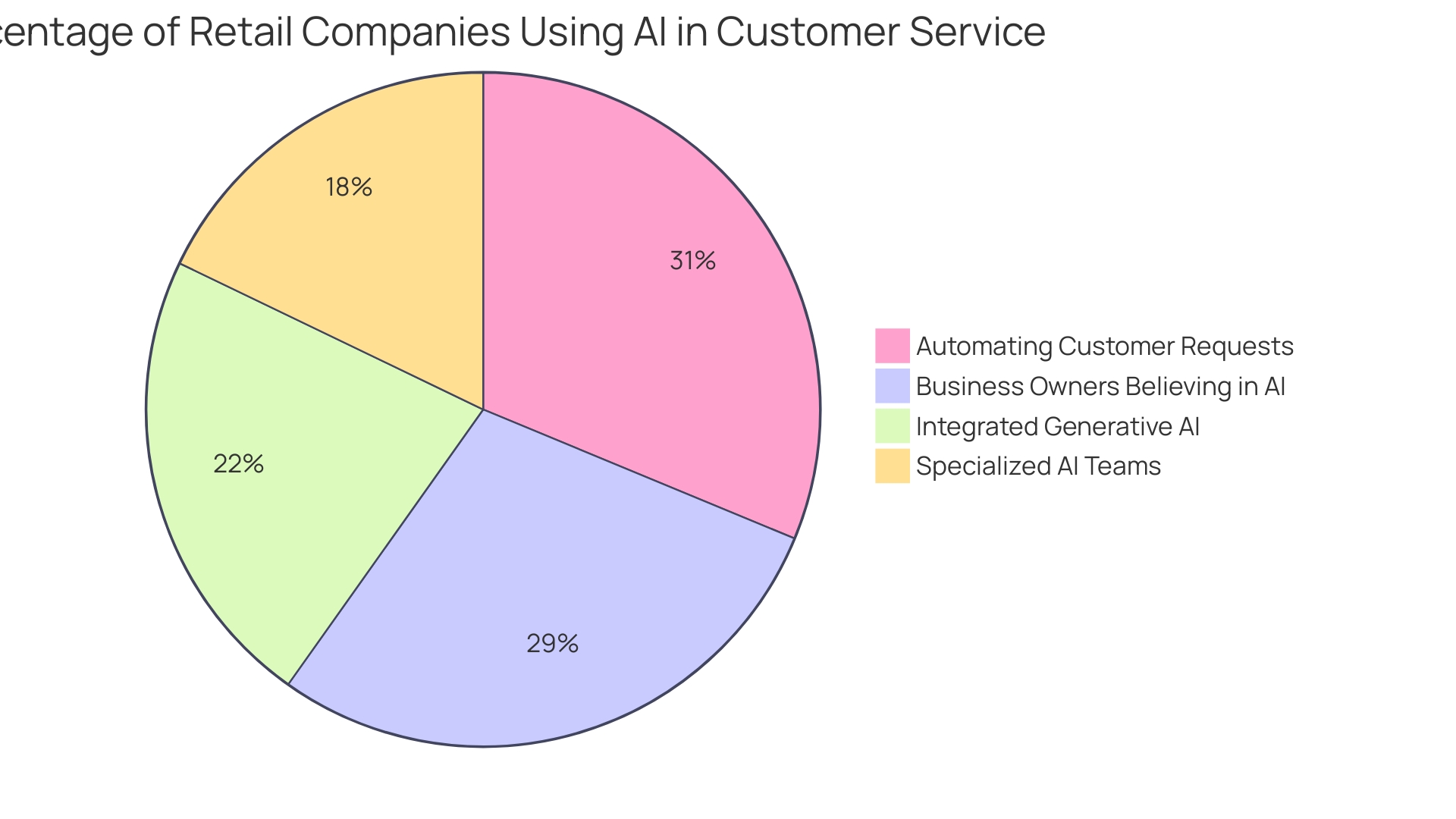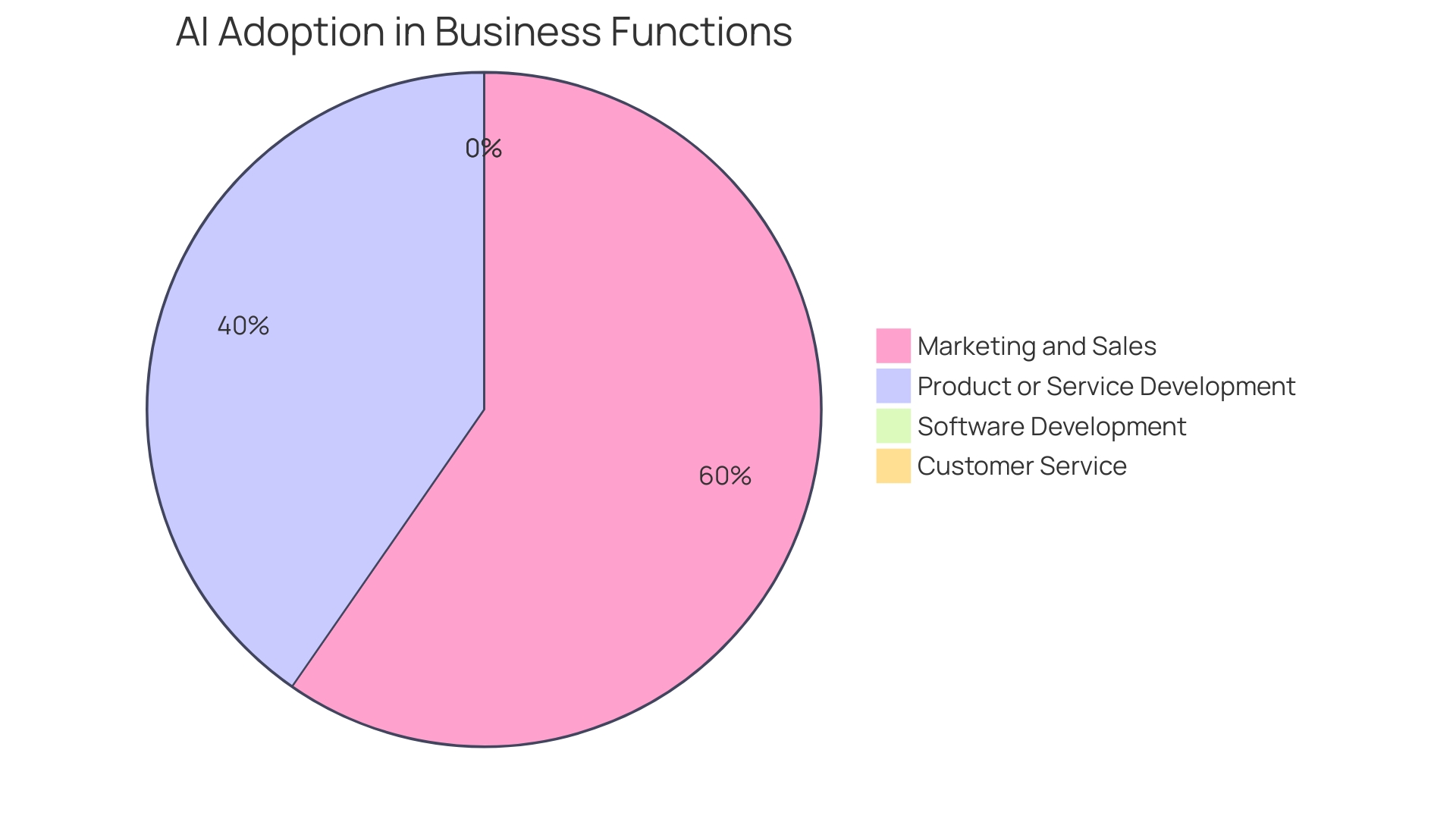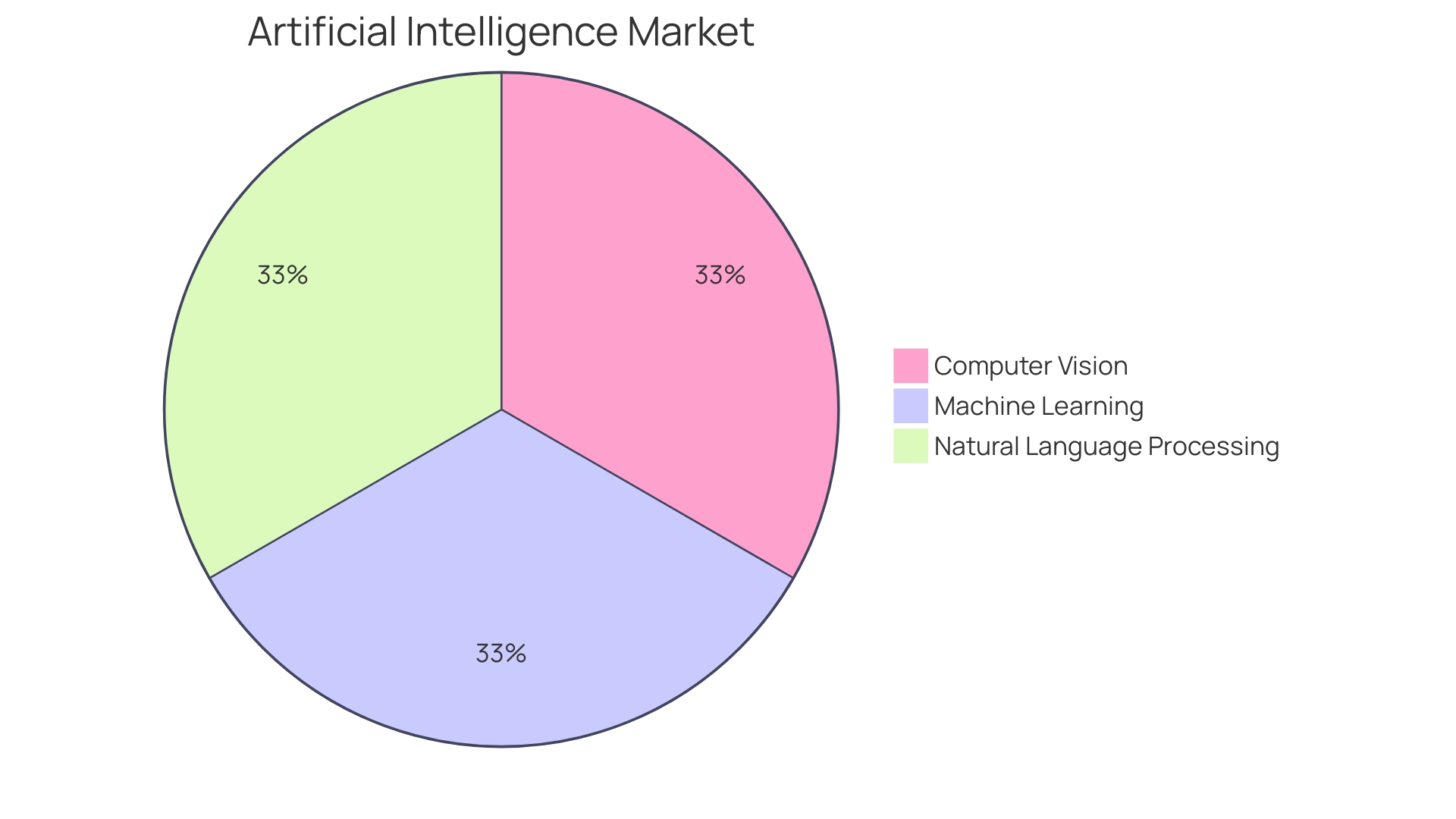Introduction
Robotic Process Automation (RPA) and Artificial Intelligence (AI) are revolutionizing business intelligence, enabling organizations to enhance operational efficiency, improve customer engagement, and drive innovation. The integration of RPA and AI streamlines operations, automates routine tasks, and empowers employees to focus on strategic initiatives. This article explores the synergy between RPA and AI in various industries, highlighting real-world implementations and the benefits and challenges of adoption.
It emphasizes the importance of data analysis, customer service, content creation, and operational efficiency. Furthermore, it navigates integration challenges and discusses future prospects and innovations in RPA and AI. With practical solutions and insights, this article sets the stage for businesses to embrace the transformative power of RPA and AI in their pursuit of smarter, more informed strategies.
The Synergy of RPA and AI: Understanding the Technologies
Robotic Process Automation (RPA) and Artificial Intelligence (AI) are transformative forces in the realm of intelligence, streamlining operations and enhancing decision-making capabilities. RPA automates mundane, repetitive tasks, liberating human resources for more strategic work. AI, on the other hand, equips machines with the ability to mimic human intelligence, tackling complex, data-driven tasks with precision.
Comprehending the collaboration between RPA and AI is crucial for enterprises. For example, the Teal IQ platform integrates AI and Machine Learning (ML) for information validation and structuring, thereby enhancing the accuracy of business intelligence. Similarly, Zara’s integration of AI throughout its supply chain exemplifies the seamless union of AI with operational processes, resulting in real-time inventory optimization and improved customer engagement.
This synergy was also demonstrated in the efficient workflow adopted by Adobe Premiere Pro, where AI-powered tools rapidly converted lengthy session recordings into concise, actionable summaries. Such applications of RPA and AI not only save time but also provide valuable information that can be utilized for strategic decisions.
Furthermore, the significance of a strong information culture is emphasized by a Harvard Business Review study, which connects it to innovation and success. Graph-based frameworks like Relational AI Graphs (RAG) further empower this by elucidating intricate data relationships, offering a richer analysis than traditional data structures.
Businesses are also advised to create libraries of tools to support the expanding technology of IA (Intelligent Automation), suggesting a gradual approach—starting with automating simpler tasks and scaling up to more complex workflows. Continuous monitoring is vital, ensuring that strategic goals are achieved and paving the way for future enhancements based on documented outcomes.
In light of the ever-evolving landscape of AI, companies are cautioned to vet AI providers meticulously, considering their industry expertise, model reliability, and commitment to innovation. Whether choosing flexible general-purpose AI models or specialized ones for domain-specific tasks, enterprises must consider the practical and financial implications.
As AI continues to drive innovation across various functions, from marketing and sales to product development, its adoption becomes crucial for maintaining a competitive edge. However, alongside its potential for spurring innovation and customer engagement, there’s a need for cautious optimism, considering the societal and ethical implications of widespread AI deployment. Thus, the alliance of RPA and AI in intelligence heralds a future where technology not only enhances efficiency but also fosters smarter, more informed strategies.
Enhancing Operational Efficiency
The integration of Robotic Process Automation (RPA) and Artificial Intelligence (AI) in business intelligence is revolutionizing the way companies operate. RPA, with its capability to automate routine tasks such as information entry and document processing, allows employees to redirect their focus towards more complex and strategic initiatives. This reallocation of human effort not only enhances productivity but also fosters innovation as the workforce engages in higher-value work.
On the other side of the spectrum, AI shines in its ability to make intelligent decisions and automate intricate processes. This dual force of technology is exemplified by companies like Zara, which has seamlessly woven AI into its operations, from supply chain management to service, ensuring real-time optimization and responsiveness.
Further illustrating the power of automation, the example of TCS’s content creation workflow demonstrates the efficiency gains from utilizing AI tools like Adobe’s Speech to Text and AI Assistant. What once took hours can now be accomplished in minutes, with a single person able to distill valuable information from lengthy sessions effortlessly.
As indicated by Coding Crafts, leading in software innovation, the synergy between RPA and AI is crucial in navigating the dynamic tech landscape. This partnership is crucial for enterprises aiming for digital transformation, as it empowers them to operate more efficiently, enhance processes, and make informed decisions based on data.
In addition, Spordle’s integrated Sports Management Platform demonstrates how AI can enhance support for clients by ensuring high satisfaction rates through quick and accurate responses, a crucial factor for growing enterprises.
In the context of intelligent automation, it’s essential to create a robust library of tools and start with automating smaller tasks, as recommended by industry experts. Continuous monitoring and documentation of results are vital to learn and apply those lessons to future projects. By doing so, businesses can not only keep pace with technological advancements but also leverage them to stay competitive and meet their operational goals.

Revolutionizing Customer Service and Engagement
Business intelligence is undergoing a transformative change with the integration of Robotic Process Automation (RPA) and Artificial Intelligence (AI), particularly in service arenas. RPA streamlines operations by handling routine tasks such as ticketing workflows and query resolutions, which not only accelerates service delivery but also enhances client satisfaction through speedy responses. Ai’s role complements by delving into interactions, predicting service requirements, and tailoring recommendations with a personal touch. This synergy is epitomized in call centers, where predictive call routing and sentiment analysis post-interaction are becoming standard practice. Despite the complexities and the challenge of real-time analytics, innovative companies like Ally have harnessed Ai’s prowess. They promote a collaborative approach to AI development, integrating insights from technical, operational, and support teams, and ensuring a human touch remains central to AI interactions. Moreover, this technological leap is supported by statistics showing the extensive adoption of AI in customer service, with over 63% of retail companies employing AI to enhance customer experiences, and up to 70% of customer requests being automated through AI. This shows a distinct pattern towards AI-driven innovation across different functions, further emphasizing the significance for companies to adjust to this change to preserve a competitive advantage.

Streamlined Content Creation and Marketing
Leveraging the synergy between Robotic Process Automation (RPA) and Artificial Intelligence (AI), businesses can vastly improve the efficiency and effectiveness of their content creation and marketing efforts. By integrating RPA, routine tasks such as aggregating and formatting information can be automated, which accelerates the content generation process. This enables a consistent and streamlined distribution of content across various platforms.
AI takes this a step further by analyzing vast amounts of customer information to glean insights into behavior and preferences. Such analysis allows for highly targeted marketing strategies, ensuring that the content reaches the appropriate audience with precision. This intelligent blend of technology not only enhances decision-making related to revenue, sales, and marketing but also simplifies complex information into actionable insights, readily accessible to stakeholders at all levels.
Case studies highlight the transformational impact of these technologies. For example, the consolidation of information into a single platform has rendered it in a standard format, accessible to teams across sales, management, and other departments. This ease of access to information, without the need for complex interpretation, empowers organizations to quickly derive valuable insights.
In the realm of marketing, industry leaders have recognized the necessity of aligning with AI. This involves rethinking data collection, segment building, and campaign management. A commitment to adopting AI principles and fostering collaboration with AI experts is essential for modern marketing strategies.
Moreover, the creator economy has embraced AI, integrating it into daily workflows. This adoption has been motivated by the necessity to remain competitive in an AI-driven landscape, where innovation and client engagement are paramount. Ai’s role in driving innovation across functions, particularly in marketing and sales, is underscored by a 34% adoption rate, proving its significance in contemporary intelligence strategies.
In conclusion, by harnessing RPA and AI, businesses can not only create and market content more efficiently but also tailor their strategies to meet the nuanced needs of their customer base, leading to better engagement and potentially increased revenue.
Advanced Data Analysis and Reporting
The integration of Robotic Process Automation (RPA) with Artificial Intelligence (AI) is revolutionizing the realm of Business Intelligence (BI), propelling organizations to new heights of data-driven excellence. RPA streamlines the arduous task of collecting information from diverse sources, while AI works its magic by analyzing this information to identify trends and extract valuable insights. With this dynamic duo at work, companies are not just keeping up but setting the pace in their industries.
For example, a prominent international logistics company once struggled with the laborious process of extracting insights from dashboard information. Their breakthrough came with BA Copilot, a solution powered by Gen-AI technology, which leveraged natural language querying and AI to enhance analysts’ efficiency. The tool not only reduced manual efforts but opened up access to information, fostering a culture of collaboration and informed decision-making throughout the enterprise.
Similarly, a Fortune 200 company overhauled its analytics by harnessing AWS to construct a modern analytics platform. This strategic move allowed for more accurate and expedited analytics requests, freeing up time for decision-making and automated insight generation. It marked a departure from legacy processes, which were slow and costly, and promoted consistency in operational guidelines.
The necessity for meticulous AI provider vetting cannot be overstated, given the potential financial and brand risks associated with security mishaps. BI tools are essential in this landscape, as they facilitate the collection, processing, and analysis of extensive information arraysâwhether structured or unstructured. This capability is crucial, as a 2023 McKinsey & Company report notes that data-driven companies tend to outperform their peers by up to 5%.
As analytics continue to evolve, the fusion of RPA and AI holds the key to unlocking unprecedented efficiency and strategic foresight. It connects the divide between scientists and business leaders, fostering a shared language and objectives that culminate in actionable intelligence. This synergy is not just a trend but a cornerstone for organizations intent on thriving in the digital age.
Industry-Specific Applications
The integration of Robotic Process Automation (RPA) and Artificial Intelligence (AI) is revolutionizing industries far and wide. In finance, these technologies are streamlining operations by automating routine tasks like invoice processing and enhancing fraud detection efforts, thereby boosting accuracy and operational efficiency. The healthcare sector benefits from Ai’s diagnostic precision and improved patient care through continuous monitoring. Manufacturing and retail are not left behind; they’re also leveraging the transformative potential of RPA and AI to optimize processes and enhance experiences.
Take, for instance, the financial services realm, where institutions grapple with an overwhelming amount of data, ranging from market trends to regulatory changes. Here, an AI-powered chatbot on AWS serves as a knowledge assistant, providing immediate, accurate responses to complex queries around the clock. Such tools help employees navigate the vast sea of information, ensuring they have the knowledge to make timely, informed decisions.
The impact of AI is evident in the numbers, with significant adoption in marketing and sales (34%) and product or service development (23%). This innovation is not just about keeping pace with technology; it’s about leading the charge in a competitive, AI-driven marketplace. By leveraging AI and RPA, businesses are not just automating; they’re reimagining what’s possible, unlocking new levels of innovation, and enhancing client engagement in previously unimaginable ways.

Case Study: Real-World Implementation of RPA and AI Synergy
Retailers are always looking for creative ways to improve operational efficiency and meet the needs of their clients. A compelling example is the application of Robotic Process Automation (RPA) and Artificial Intelligence (AI) in inventory management, as demonstrated by a leading retail organization. By automating routine inventory tasks, the company streamlined its processes and, with Ai’s predictive analytics, could anticipate consumer demand and maintain optimal stock levels. This strategic integration not only minimized the occurrence of stockouts but also led to notable cost savings and an uptick in client satisfaction.
Highlighting the usefulness of starting with low-complexity, high-return tasks, the strategy of this company reflects industry trends where retailers initiate their digital upgrade with straightforward enhancements like automated identity verifications and basic inquiries. The narrative aligns with insights from Anand Raghavendran’s appointment at KlearNow, where his expertise is set to enhance the firm’s AI-driven supply chain solutions.
Furthermore, the wider retail industry is experiencing a period of full automation that spans from client interactions to backend operations, highlighting a crucial transition towards a more efficient and empowered retail setting. Christopher Schyma, Director of Retail at Sutherland, supports this view, indicating that AI-driven automation will profoundly reshape the retail industry. As retailers navigate through operational challenges, the implementation of such technologies not only solves immediate pain points but also sets the stage for future growth and transformation.
Benefits and Challenges of Adoption
Embracing robotic process automation (RPA) and artificial intelligence (AI) in intelligence is a game-changer for organizations aiming to enhance operational efficiency and client engagement. This revolutionary jump allows businesses to automate repetitive tasks through bots capable of handling information input, transaction processing, and service interactions. Such integration of automation technology not only streamlines content creation but also enhances the quality of analysis, allowing for strategic, information-driven decision-making.
The impact of RPA and AI is evident in the case of Bosch, where their deployment of a solid oxide fuel cell (SOFC) system, complemented by a digital twin, showcases how automation and digitalization can drive sustainability. With an electrical efficiency of 60 percent, the SOFC system exemplifies the potential of these technologies to optimize performance and cost over a system’s lifetime. Similarly, Spordle’s Sports Management ERP demonstrates automation’s role in unifying operations across sports federations and clubs, enhancing the efficiency of customer support and knowledge base management.
However, the journey towards full AI and RPA integration is not devoid of hurdles. Challenges in integration complexities, security, and the scarcity of skilled professionals are significant. As evidenced by the need for rigorous vetting of AI providers, considering their industry expertise, track record, and financial stability is crucial to safeguard sensitive data and ensure long-term partnerships. This examination extends to the AI models’ performance and scalability, ensuring they align with the changing requirements of the organization.
Moreover, as executives contemplate the ROI of AI investments, it is clear that organizations are only beginning to tap into Ai’s potential. With 70-80% of enterprises still relying on spreadsheets for essential tasks, the chance to decrease inefficiencies and errors through automation is immense. Nevertheless, the transition to advanced tools must be managed with care to avoid disrupting existing operational flows.
Overall, the fusion of RPA and AI into intelligence holds the potential of driving efficiency, innovation, and growth. The keys to unlocking this promise are strategic planning, collaborative efforts among stakeholders, and a commitment to continuous improvement in the face of technical and organizational challenges.
Navigating Integration Challenges
The integration of Robotic Process Automation (RPA) and Artificial Intelligence (AI) into business intelligence initiatives is more than just a trend; it’s a strategic imperative. The essence of this integration lies in understanding the current operational processes and how they function in reality, a task often underestimated by organizations. For instance, while process documentation might suggest a straightforward workflow, the actual day-to-day operations could reveal a complex array of deviations and exceptions. Gaining near real-time visibility into these processes is crucial for any meaningful improvement and decision-making.
Consider the order-to-cash process. Here, credit blocks are designed to prevent orders from high-risk non-paying individuals. However, these blocks can inadvertently delay transactions for reliable customers due to a cumbersome removal process. The solution to streamlining this process may lie in using tools like Palantir HyperAuto to integrate relevant information from various systems and enhance process mining capabilities.
Furthermore, integration is crucial for effective decision-making. It involves extracting information from diverse systems, standardizing it to a common format, and consolidating it into a unified database, thus addressing the challenges posed by information silos. These silos, which arise from information being stored in isolated systems or departments, can lead to an incomplete comprehension of the organization and impede well-informed decision-making.
This process is not without its challenges. As indicated by specialists, transformation assignments concerning information have historically been challenging and require a lot of effort. However, once systems like Salesforce are in place, they tend to become deeply embedded within a business’s infrastructure. The push towards APIs signifies a shift from manual document exchanges to direct system-to-system communication. This evolution emphasizes the significance of choosing AI vendors with a strong history and a clear comprehension of the potential risks, such as breaches, associated with AI technologies.
In the context of Knowledge Management, the ‘last mile problem’ illustrates the difficulties of delivering services from a central system to the end-user. ChatGPT’s success has spurred Fortune 1000 IT departments to actively seek solutions to this problem, thereby improving productivity inefficiencies.
Statistics emphasize that not all information is good, underscoring the significance of data quality and integrity. Insufficient information can arise from organizational silos, making it difficult for AI/ML models to precisely depict intricate corporate behaviors that encompass multiple domains. To overcome these hurdles, companies are advised to create a library of tools to support IA use, start with automating smaller tasks, and continuously monitor and document results to guide future projects.
In conclusion, successful integration of RPA and AI in intelligence not only necessitates a well-defined implementation plan but also an in-depth understanding of the operational realities. Thorough testing and continuous monitoring are essential to tackle integration challenges, ensuring data privacy and security while harnessing the transformative powers of AI for intelligence.
Future Prospects and Innovations in RPA and AI
As the scenery of intelligence in the corporate world continues to change with technological advancement, the combination of Robotic Process Automation (RPA) and Artificial Intelligence (AI) stands at the forefront of this transformation. The integration of RPA with advanced AI capabilities, such as natural language processing, is not merely an addition to existing frameworks but a revolutionary approach that empowers systems with predictive analytics and intelligent decision-making. Tools like chatbots, infused with AI, are now capable of providing sophisticated customer support that goes beyond simple query resolution.
Organizations are increasingly recognizing the need to implement intelligent automation to navigate their digital transformation journey effectively. By embracing a gradual approach, beginning with the automation of basic tasks and progressively expanding to more intricate operations, organizations can ensure the smooth integration of these technologies. This approach is vital for gaining immediate value from AI-driven tools such as Raia’s Data Analyst, which can be integrated effortlessly into workspaces to assist in data analysis and liberate teams to focus on more strategic tasks.
To truly harness the potential of AI and RPA, continuous monitoring and documentation of outcomes is crucial. This not only confirms that objectives are being met but also provides a repository of insights and learnings for future endeavors. As we’ve seen with the transformative impact of SS&C Blue Prism’s document automation, these technologies are no longer confined to performing simple tasks; they are reshaping entire processes.
The AI market is experiencing exponential growth, projected to reach a market volume of US$738.80bn by 2030, indicating the tremendous potential for businesses to innovate and maintain a competitive edge. Forward-thinking organizations that leverage these advancements in AI and RPA are not just streamlining operations; they are setting new industry benchmarks for efficiency and strategic insight.

Conclusion
In conclusion, the integration of RPA and AI is revolutionizing business intelligence. This powerful synergy streamlines operations, enhances efficiency, and drives innovation across various industries. By automating routine tasks and leveraging AI’s data analysis capabilities, organizations can optimize processes, improve customer engagement, and make data-driven decisions.
The benefits of adopting RPA and AI are evident. From inventory management in retail to fraud detection in finance, these technologies transform operations, boost accuracy, and increase customer satisfaction. Automating content creation and marketing efforts enables efficient distribution, while AI’s insights lead to targeted strategies and actionable results.
However, there are challenges to navigate. Complex integration, data security, and the scarcity of skilled professionals pose hurdles. By vetting AI providers, ensuring data quality, and continuously monitoring outcomes, businesses can overcome these challenges and harness the transformative power of RPA and AI.
Looking ahead, the prospects for RPA and AI are promising. The integration of RPA with advanced AI capabilities empowers systems with predictive analytics and intelligent decision-making. By adopting a step-by-step approach and monitoring outcomes, organizations can navigate their digital transformation journey and stay ahead in a rapidly changing business landscape.
In summary, the synergy between RPA and AI revolutionizes business intelligence. By embracing RPA and AI, organizations can streamline operations, automate tasks, and make data-driven decisions. With practical solutions and continuous improvement, businesses can harness the transformative power of RPA and AI to thrive in the digital age and maintain a competitive edge.

